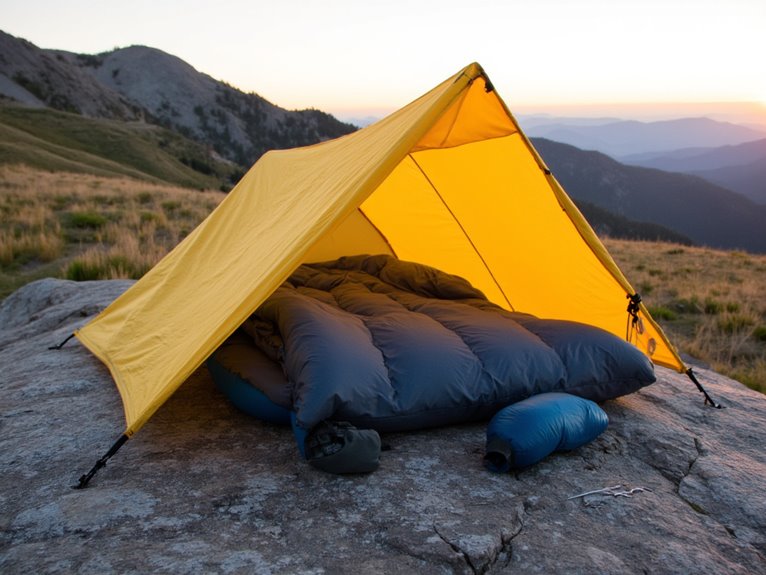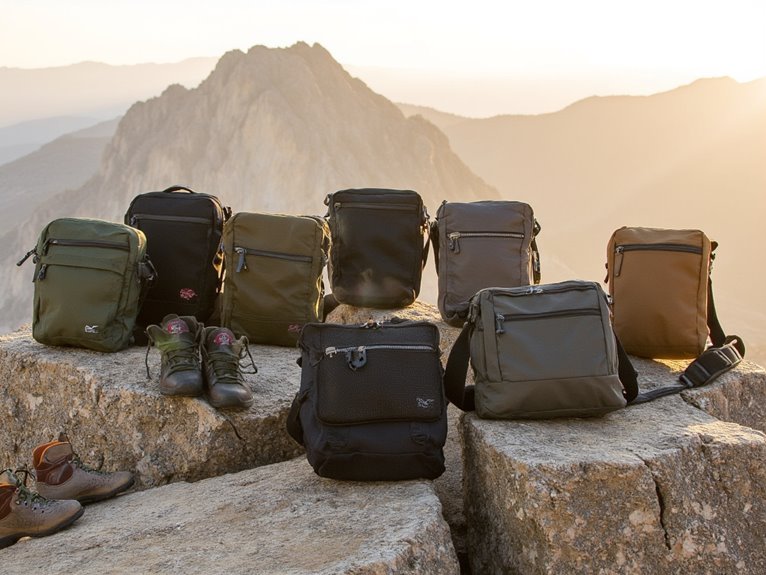Bikepacking Sleep Systems: Space-Saving Strategies That Work
Effective bikepacking sleep systems prioritize high fill-power down insulation (700-800+) and ultralight materials like Dyneema composite fabric, which reduces weight by 30-50% compared to standard options. You’ll maximize space by stuffing sleeping bags into compression sacks while rolling clothing items separately. Choose sleeping pads with R-values matching temperature requirements rather than oversized options, and select quilt-style bags over traditional mummy designs. Proper compression techniques and gear selection transform your setup’s efficiency and performance potential.
We are supported by our audience. When you purchase through links on our site, we may earn an affiliate commission, at no extra cost for you. Learn more. Last update on 10th December 2025 / Images from Amazon Product Advertising API.
Notable Insights
- Use compression sacks made of cuben fiber to reduce sleeping bag storage weight by 30-50% compared to traditional sacks.
- Replace heavy mummy bags with quilt-style sleeping bags and choose ultralight materials like silnylon or dyneema for shelters.
- Roll clothing items and stuff sleeping bags properly; rolling preserves insulation while stuffing bags can damage fill over time.
- Select sleeping pads with compact carry bags and R-values matching temperature needs to avoid unnecessary bulk while maintaining warmth.
- Choose high fill power down insulation (700-800+) for superior warmth-to-weight ratios and better compression compared to synthetic materials.
The Core Components of an Efficient Sleep System
When building a bikepacking sleep system, you’ll need to balance four essential components: shelter, sleeping bag, sleeping pad, and strategic weight distribution.
Your shelter options range from ultralight tents weighing under two pounds to minimalist tarps that pack smaller but require setup skills. Bivy sacks offer weather protection with maximum packability.
Insulation types in sleeping bags include down fill for superior warmth-to-weight ratios and synthetic materials that retain heat when wet. Temperature ratings must match expected conditions—a 20°F bag weighs considerably more than a 40°F version.
Sleeping pads provide vital ground insulation and comfort. R-values indicate thermal resistance: higher numbers mean better insulation. Foam pads are reliable but bulky, while inflatable options compress smaller but risk punctures.
Distribute weight across frame bags, handlebar rolls, and seat packs to maintain bike handling and maximize storage efficiency. For extreme cold conditions, lightweight 0-degree sleeping bags can weigh as little as 2.5 pounds with proper down insulation while still providing life-saving warmth.
Balancing Comfort and Packability for Long Tours
When you’re planning multi-day bikepacking tours, you’ll face critical decisions about gear weight that directly impact your riding performance and sleep quality.
Every ounce counts on long climbs, but sacrificing comfort can lead to poor sleep that compounds fatigue over successive days.
Your sleep system choices must consequently balance the packability needed for efficient pedaling with the comfort requirements that guarantee proper recovery during extended adventures.
Modern ultralight sleeping pads offer an excellent solution, with top models weighing just 15.9 oz while compressing to the size of a water bottle for efficient bikepacking storage.
Gear Weight Trade-offs
Although many bikepackers obsess over every gram in their sleep systems, the actual performance impact of additional weight remains surprisingly minimal on most tours.
One kilogram adds just 1–2 minutes per hilly 100km, while flat terrain shows only 10–20 seconds delay. Even carrying 30kg extra gear equates to roughly 5 minutes daily. This data suggests you shouldn’t sacrifice comfort for marginal weight savings.
Effective weight distribution and load management matter more than absolute numbers.
Down sleeping bags offer superior packability but cost more than synthetic alternatives. Inflatable pads compress smaller than foam options yet risk punctures.
Your sleep system’s 0.9–2.3kg range allows flexibility based on tour conditions.
Prioritize sleep quality over minimal weight reductions—better rest improves endurance and overall performance considerably.
Multi-Day Comfort Priorities
Extended bikepacking tours demand a fundamental shift from ultralight philosophy toward sustainable comfort systems that maintain performance across weeks rather than days.
Your sleeping environment becomes critical when consecutive poor nights compound fatigue and reduce decision-making capacity on technical terrain.
Long tours justify prioritizing comfort items that improve sleep quality and temperature regulation. A wider sleeping pad (25″ vs. 20″) and inflatable pillow prevent pressure points that develop over multiple nights.
Consider these comfort upgrades:
- Insulated air mats with R-values above 4.0 for consistent warmth across varied terrain
- Modular quilt systems allowing temperature adjustment without carrying multiple bags
- Robust shelter systems with vestibules for gear storage and cooking protection
Your gear selection should emphasize durability and versatility over minimal weight when tour duration exceeds one week.
Compression Techniques That Maximize Frame Bag Space
Your choice between rolling and stuffing compression methods directly impacts how much gear you’ll fit in your frame bag triangle.
Rolling works best for clothing and soft fabrics because it eliminates air pockets and creates uniform cylindrical shapes that stack efficiently, while stuffing suits sleeping bags and puffy insulation where maintaining loft isn’t critical during transport.
The compression sack you select must match your gear type—lightweight silnylon sacks with drawstring closures excel for clothing at 2-4 ounces, whereas heavy-duty compression sacks with side straps handle sleeping bags and can reduce volume by 40-60%.
For sleeping pads specifically, look for models that compress into compact carry bags, with some ultralight options achieving pack sizes as small as 10×5.9 inches while maintaining the 3-4 inch thickness needed for comfortable sleep.
Rolling Vs Stuffing Methods
When packing your sleeping system into frame bags, the compression method you choose directly impacts both available space and gear longevity.
Rolling advantages include preserving insulation loft, reducing fabric wrinkles, and creating uniform shapes for efficient stacking. Rolling also enables quick visual identification and maintains organization within compartments.
However, stuffing disadvantages become apparent with prolonged use. Aggressive compression can damage down or synthetic fill, reducing thermal performance over time. Stuffing creates irregular shapes that waste valuable frame bag space and makes gear retrieval difficult.
Consider these key factors:
- Frame bag geometry – narrow compartments favor rolled items
- Insulation type – down requires gentler rolling compression
- Access frequency – roll items you need quick access to
Rolling typically extends gear lifespan while maximizing organizational efficiency.
Compression Sack Selection
While rolling techniques enhance organization, compression sacks represent the most efficient method for maximizing frame bag capacity and protecting sleep system components.
Your compression sack comparison should evaluate three primary options:
- EVac Compression Dry Bag HD features 420D fabric for heavy-duty applications.
- Lightweight Compression Sacks use RCS-recycled materials with excellent strength-to-weight ratios.
- Ultra-Sil EVENT Compression Dry Sacks compress gear to one-third original size.
Waterproof materials matter considerably in wet climates.
Choose waterproof sacks for rain-prone conditions, water-resistant options for lighter needs.
Width-wise compression enhances frame bag fit better than length-wise compression.
Select sacks with four evenly-placed compression straps for uniform compression.
Roll-top closures eliminate valve failure points while maintaining effectiveness.
Choose the largest sack that fits your frame bag while maintaining adequate clearance for optimal space utilization.
Weight-Shaving Gear Selections for Ultralight Setups

Every gram matters when you’re pedaling hundreds of miles with your entire camp strapped to your bike frame. Smart gear selections can slash pounds from your sleep system without sacrificing comfort or warmth.
Essential Weight-Cutting Strategies:
- Replace traditional mummy bags with quilt-style sleeping bag alternatives – eliminates zippers and excess fabric while maintaining thermal efficiency.
- Select ultralight materials like silnylon or dyneema composite fabric for shelter components instead of heavier ripstop nylon.
- Choose titanium stakes over steel alternatives – saves 50-100 grams while providing superior strength-to-weight ratios.
Down insulation consistently outperforms synthetic fill in warmth-to-weight calculations. High-quality fill power down (700-800+) offers the best compression ratios for bikepacking where frame bag space is at a premium. Sleeping pads under 500 grams with R-values matching your temperature requirements prevent unnecessary bulk.
Compression sacks utilizing cuben fiber weigh 30-50% less than traditional stuff sacks while maintaining weather protection.
Advanced Materials and Technologies Worth the Investment
Since traditional fabrics and basic insulation systems can’t match the performance demands of serious bikepacking, investing in advanced materials becomes essential for riders pushing weight and space limitations.
Dyneema® Composite Fabric reduces sleep system weight by 30-50% compared to standard materials. You’ll find DCF in premium tents and tarps from brands like Zpacks, offering waterproof protection with superior packability.
Advanced insulation technologies like Thermal Mirror™ metallized film layers reflect body heat efficiently while maintaining low bulk. These systems boost R-values without added weight penalties.
Ultralight fabrics including 100% recycled 20D polyester provide durability matching virgin materials.
Spaceframe™ baffle construction eliminates the springy “waterbed” effect in sleeping pads. Ultra-thin internal films reduce convection currents for consistent warmth.
These innovations enable sub-2-pound shelter weights with carbon pole frames. For bikepacking applications, ultralight sleeping pads ranging from 15.9 to 20 ounces provide the best balance between thermal protection and packability constraints.
Field-Tested Maintenance Tips for Reliable Performance
After investing in premium materials and advanced technologies, proper field maintenance becomes the determining factor between gear that performs reliably and equipment that fails when you need it most.
Effective zipper maintenance starts with pre-trip lubrication using specialized zipper wax or lubricant on all zippers—sleeping bags, jackets, and tents. Clean zipper tracks regularly to remove grit that causes jamming. Store gear loosely rather than compressed to prevent zipper stress.
For pad repairs, master leak detection using soapy water to identify bubbles around punctures. Always clear your campsite of sharp debris before setup.
Essential Field Maintenance Protocol:
- Apply zipper lubricant before every trip and inspect tracks for damage
- Carry patch kits and learn proper application techniques for immediate repairs
- Air out sleeping bags and pads daily to prevent moisture buildup and material degradation
Monitor your sleeping bag for persistent odors or reduced loft, as these indicate when annual cleaning becomes necessary to maintain insulation performance.



